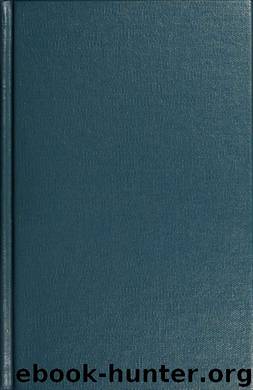Introduction to general chemistry by McCoy Herbert Newby 1870-

Author:McCoy, Herbert Newby, 1870- [from old catalog] & Terry, Ethel Mary, [from old catalog] joint author
Language: eng
Format: epub
Tags: Chemistry
Publisher: Chicago, Ill. [Univeristy of Chicago press]
Published: 1919-03-25T05:00:00+00:00
Fig.
each other is proportional to the product of their charges and inversely proportional to the square of the distance between them. There is, however, one additional factor that determines the strength of the attraction, and that is the nature of the surrounding medium. Usually this is air. If the medium were
glass instead of air the attraction would be only about one-third as great, other things remaining the same; but if the medium were water the attraction would be only one-eightieth as great as for air. If then we dissolve NaCl in water, the molecules are surrounded by a medium which lessens enormously the attractive force which holds their parts together; as the result, molecules will tend to fall apart, thus,
NaCl->Na+ + Cl-.
The positive part is the sodium ion, the negative part the chlorine ion. According to this explanation the molecule of salt before it ionizes is made up of two oppositely charged parts. These are not ordinary atoms, since the one has lost an electron which the other has gained. We ought to say that the NaCl molecule is made up of a sodium ion (Na + ) electrically bound to an ion of chlorine (Cl~). The act of ionization, which takes place when the salt is dissolved, is only the falling apart of the ions already present, on account of the great decrease in attractive force caused by the surrounding water. In other words, molecules are composed of bound ions, while in solution part of the ions are free. The ionization of all acids, bases, and salts is explained in precisely analogous fashion to that in the case of NaCl.
487. The Electronic Description of Electrolysis. —According to the electronic description of electrolysis, when an ion reaches an electrode it either gains electrons or loses them. Thus the positive ions Cu ++ , Pb ++ , H + , etc., each gain enough electrons to make them electrically neutral; while Cl~, I~, S~~, and 0~~ each lose electrons and become free elements.
488. The Displacement of Non-metals by One Another. —It will be recalled that chlorine acts on a solution of hydrobromic acid or any bromide, setting free bromine, thus:
CL+ 2HBr->Br 2 + 2HCI. (259)
Similarly bromine acts on iodides, as, for example: Br 2 +2KI->I 2 + 2 KBr.
Download
This site does not store any files on its server. We only index and link to content provided by other sites. Please contact the content providers to delete copyright contents if any and email us, we'll remove relevant links or contents immediately.
Whiskies Galore by Ian Buxton(41550)
Introduction to Aircraft Design (Cambridge Aerospace Series) by John P. Fielding(32900)
Rewire Your Anxious Brain by Catherine M. Pittman(18334)
Craft Beer for the Homebrewer by Michael Agnew(17944)
Cat's cradle by Kurt Vonnegut(14798)
Sapiens: A Brief History of Humankind by Yuval Noah Harari(14004)
Leonardo da Vinci by Walter Isaacson(12828)
The Tidewater Tales by John Barth(12412)
Underground: A Human History of the Worlds Beneath Our Feet by Will Hunt(11851)
Thinking, Fast and Slow by Kahneman Daniel(11825)
The Radium Girls by Kate Moore(11644)
The Art of Thinking Clearly by Rolf Dobelli(9946)
A Journey Through Charms and Defence Against the Dark Arts (Harry Potter: A Journey Throughâ¦) by Pottermore Publishing(9144)
Mindhunter: Inside the FBI's Elite Serial Crime Unit by John E. Douglas & Mark Olshaker(8741)
Tools of Titans by Timothy Ferriss(7838)
Wonder by R. J. Palacio(7751)
Turbulence by E. J. Noyes(7725)
Change Your Questions, Change Your Life by Marilee Adams(7395)
Nudge - Improving Decisions about Health, Wealth, and Happiness by Thaler Sunstein(7269)
